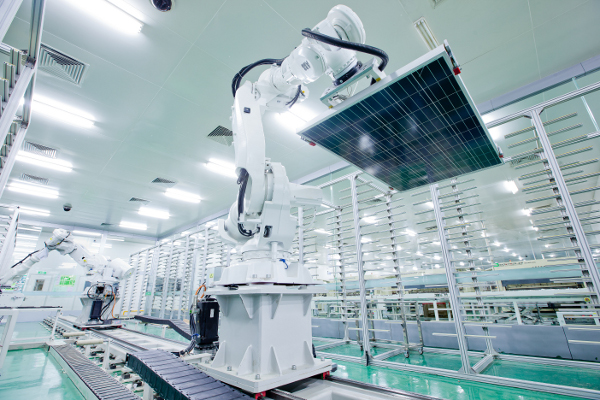pv magazine: In which situations are bifacial glass-backsheet modules best suited, and when is it better to use bifacial glass-glass-modules?

Andrea Viaro, head of technical service Europe, JinkoSolar: The transparent backsheet modules are more suitable and competitive for the project designs that require lightweight modules. In this way, it is possible to BOS (balance of systems) costs, thanks to the panel’s lighter weight and easier installation method comparable to traditional glass-backsheet, framed modules.
One of the advantages of double glass laminate modules is that they may bring extra comfort in specific applications, such as projects done in sandy environments, mainly due to rear-side transparency in the long run. Beside the laminate structure, another point of differentiation lies in the framed or unframed option. The framed version, in particular, is more suitable for tracking systems or floating projects, as they give the highest mechanical resistance against possible severe mechanical stress.
Join Andrea Viaro and Lucie Garreau-iles as they discuss their thesis during the upcoming pv magazine webinar, New approach for bifacial modules and yield expectations, on Monday 29 April at 2pm (CEST). Powered by JinkoSolar, Viaro and Garreau-iles present their conclusions on the new approach using a transparent backsheet for bifacial modules, followed by a presentation from TÜV Rheinland on the results of a bifacial gain study More information and free registration click hereFind out more at upcoming pv magazine webinar...
In terms of technical data, bifaciality and yield expectations, how does the glass-backsheet module compare with bifacial glass-glass-module?
Andrea Viaro: JinkoSolar’s complete bifacial module portfolio comes with a 30 year linear power warranty, hence they offer the same long-term reliability and extended energy generation. Both module versions can reach the same power class on the front-side and similar efficiency levels on the rear-side, consequently they have equivalent power gains in the different albedo scenario, ranging from 5% in basic conditions up to even 30% in an optimized installation setup. Our bifacial modules use high-efficiency mono-PERC Cheetah technology with a 158.75mm cell size that can reach up to 400Wp on the front side, in combination with JinkoSolar’s half -cell technology. The so-called “ceramic glass” technology can be applied on dual-glass modules to boost the internal light reflections; and a similar technique can be emulated also on the glass-backsheet version. By means of this particular add-on solution, the module nominal class can reach almost the same wattage of the Cheetah’s highest power modules on the front side.
The backsheet used in the bifacial glass-backsheet modules originates from DuPont. What makes you so confident that glass backsheet modules can compete with glass-glass modules in terms of reliability and longevity?

Lucie Garreau-iles, technical manager, EMEA, DuPont: There is already some data on glass-glass-panels. I think the first official launch of the glass-glass-structure was at PVSEC 2015, showing four people from Japan standing on the panels and promoting this concept. A lot of other module manufacturers followed suit and within a year, pretty much all panel manufacturers were exhibiting glass-glass-panels at Intersolar. They were not bifacial panels at that time, but some of the problems are still the same in terms of material aging. As such, we have data for modules with polymer backsheets and data for glass-glass-modules. Also, a JRC study gives us means of comparing performance of glass-glass panels to glass-backsheets. The backsheets win in this study.
Popular content
With the evolving EVA formulations, and changes in cell technologies, the problems will be exacerbated in the glass-glass-panels. Now I agree that transparent backsheets face a very big challenge concerning UV. This is why you have to follow the appropriate test sequence that will allow you to assess backsheet materials against their inherent weakness. For glass, the challenge is its brittleness, so the dynamic mechanical load test seems very adequate. For polymer backsheets, the UV resistance with humidity is the prime test in combination with thermal cycle for reveal embrittlement. The field taught us how to test, now the tests should allow us to go back to the field with sound new developments!
DEEP DIVE DISCUSSION at Quality Roundtable Europe, May 16: Glass-glass modules are gaining market share – are they really more reliable?
At last year’s pv magazine Quality Roundtable at Intersolar Europe 2018, experts were surprised by DuPont’s doubts on the reliability of glass-glass modules (see last question). This year, we ask the company to explain their doubts in more detail, and have invited independent experts from PI Berlin, imec, and CEA to discuss them in the first session of this year’s Roundtable, at Intersolar Europe on Thursday May 16, at 14:30.
As you are one of the leading companies that supplies components for backsheets, readers could think that your evaluation contains some bias. How do you select samples, and is it possible that there is bias in your statistics?
Lucie Garreau-iles: Since we started inspecting solar arrays around the world in 2011, we have developed a downstream network and partners regularly come forward to ask us to assess the health of their solar assets. There is still a healthy mixture of good and bad. So the sample is still fairly random.
Now if we were in a more service oriented dynamic, then we would have to analyze our sample knowing that it would then be more defect-based. There is still good information to extract from a defect-based sampling, but you have to state the basis for the sample selection. In our case, it is still fairly random. Usually, we do not know the backsheet material we are going to see, because our partners often do not know themselves, and the module makers do not tend to supply this information on the datasheet. So even if we go and see a problem (that means we sample based on defect), the backsheet material selection is completely random.
 In the upcoming webinar, moderated by Michael Fuhs, editor in Chief, Andrea Viaro and Lucie Garreau-iles will be joined by TÜV Rheinland expert Johanna Bonilla, who will present yield analysis for bifacial installations and insights in the IEC 60904-1-2 (2019), which describes the procedures for the measurement of the current-voltage (I-V) characteristics of bifacial modules.
In the upcoming webinar, moderated by Michael Fuhs, editor in Chief, Andrea Viaro and Lucie Garreau-iles will be joined by TÜV Rheinland expert Johanna Bonilla, who will present yield analysis for bifacial installations and insights in the IEC 60904-1-2 (2019), which describes the procedures for the measurement of the current-voltage (I-V) characteristics of bifacial modules.
On Monday 29 April, at 2pm during the webinar live broadcast, together we will examine the reliability claims of JinkoSolar and DuPont on their latest productions, as well as discuss the impact of bifacial modules on LCOE, and the yield analysis for bifacial installations by TÜV Rheinland.
To register for free, click here.
This content is protected by copyright and may not be reused. If you want to cooperate with us and would like to reuse some of our content, please contact: editors@pv-magazine.com.


By submitting this form you agree to pv magazine using your data for the purposes of publishing your comment.
Your personal data will only be disclosed or otherwise transmitted to third parties for the purposes of spam filtering or if this is necessary for technical maintenance of the website. Any other transfer to third parties will not take place unless this is justified on the basis of applicable data protection regulations or if pv magazine is legally obliged to do so.
You may revoke this consent at any time with effect for the future, in which case your personal data will be deleted immediately. Otherwise, your data will be deleted if pv magazine has processed your request or the purpose of data storage is fulfilled.
Further information on data privacy can be found in our Data Protection Policy.